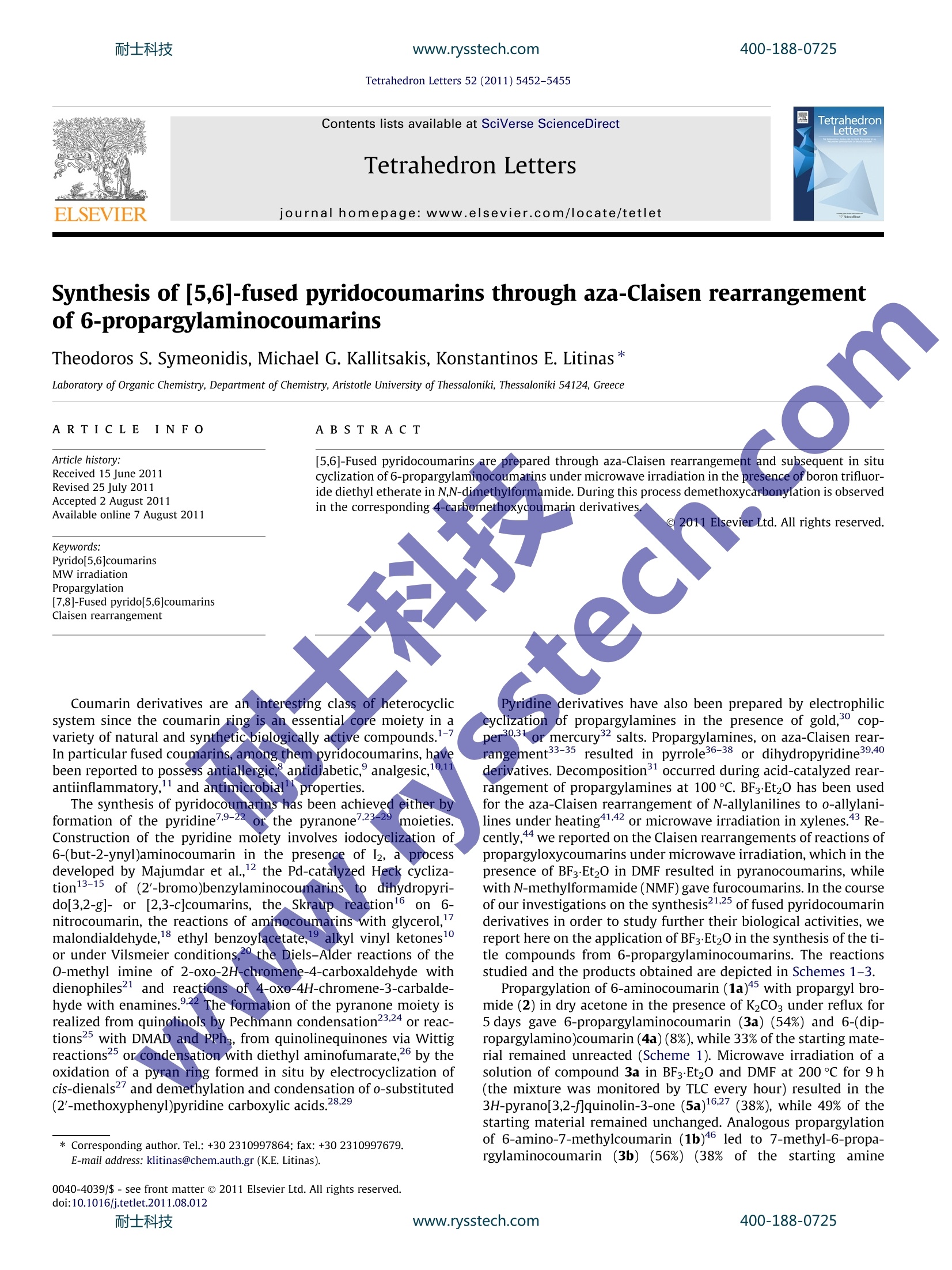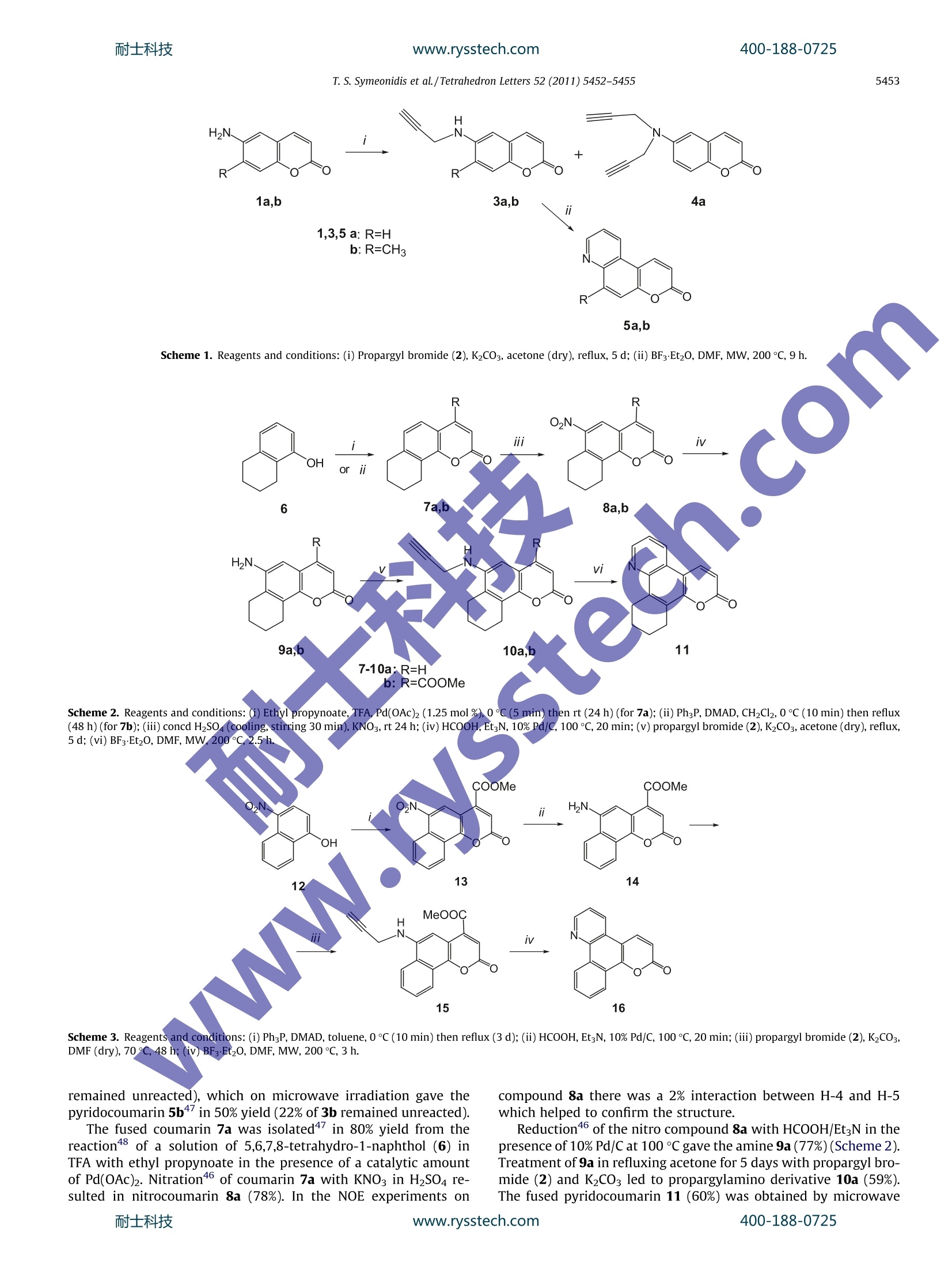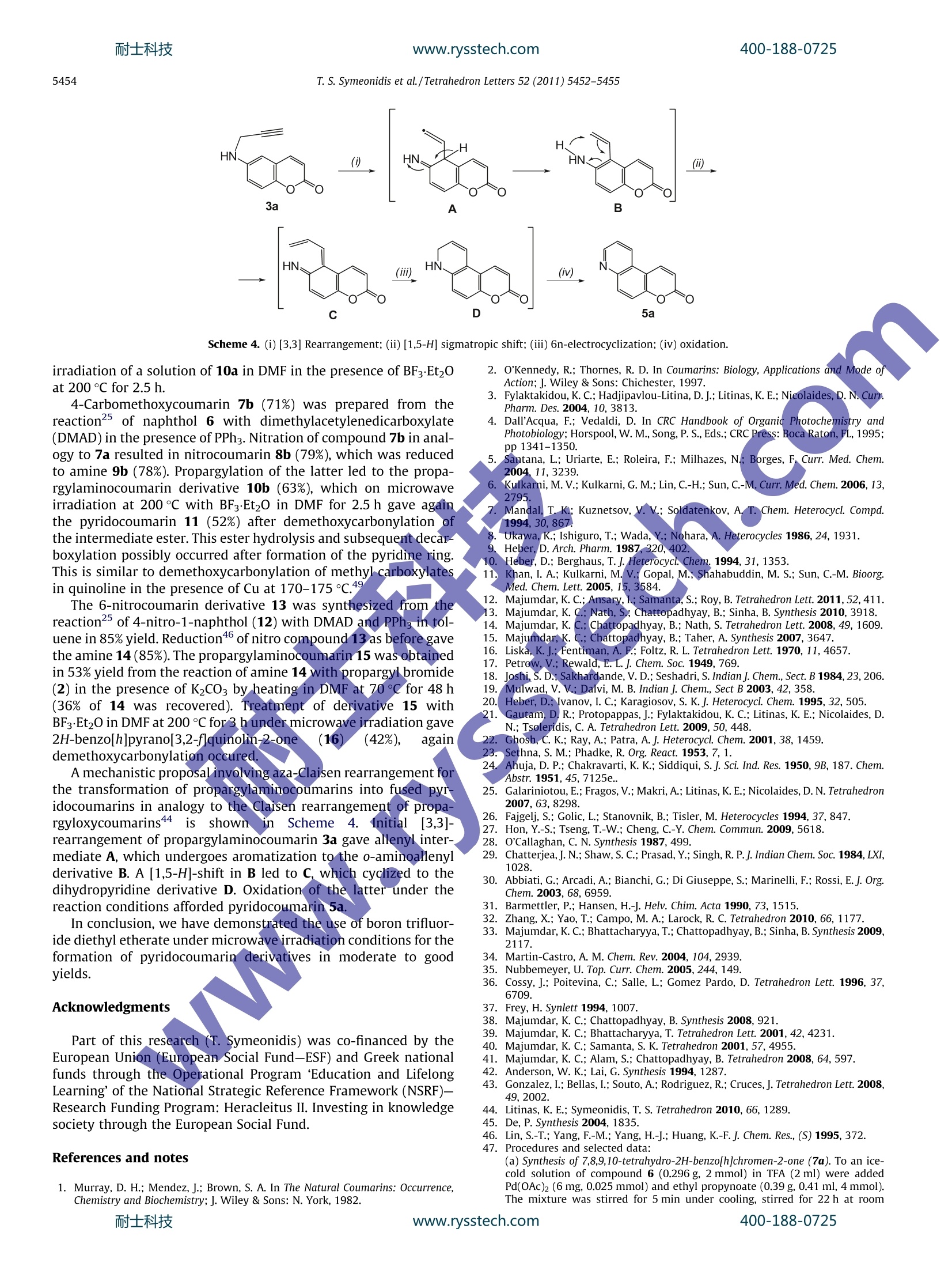
方案详情
文
[5,6]-Fused pyridocoumarins are prepared through aza-Claisen rearrangement and subsequent in situ cyclization of 6-propargylaminocoumarins under microwave irradiation in the presence of boron trifluoride diethyl etherate in N,N-dimethylformamide. During this process demethoxycarbonylation is observed in the corresponding 4-carbomethoxycoumarin derivatives.
方案详情

耐士科技400-188-0725www.rysstech.comTetrahedron Letters 52 (2011)5452-5455 耐士科技400-188-0725www.rysstech.com5453 Contents lists available at SciVerse ScienceDirect Tetrahedron Letters E LSEVIER journal homepage:www.elsevier.com/locate/tetlet Synthesis of [5,6]-fused pyridocoumarins through aza-Claisen rearrangementof 6-propargylaminocoumarins Theodoros S. Symeonidis, Michael G. Kallitsakis, Konstantinos E. Litinas * Laboratory of Organic Chemistry, Department of Chemistry, Aristotle University of Thessaloniki, Thessaloniki 54124, Greece ARTICLE I N F O ABSTRACT Article history:Received 15 June 2011Revised 25 July 2011Accepted 2 August 2011Available online 7 August 2011 [5,6]-Fused pyridocoumarins are prepared through aza-Claisen rearrangement and subsequent in situcyclization of 6-propargylaminocoumarins under microwave irradiation in the presence of boron trifluor-ide diethyl etherate in N,N-dimethylformamide. During this process demethoxycarbonylation is observedin the corresponding 4-carbomethoxycoumarin derivatives. Coumarin derivatives are an interesting class of heterocyclicsystem since the coumarin ring is an essential core moiety in avariety of natural and synthetic biologically active compounds.'-7In particular fused coumarins,among them pyridocoumarins, havebeen reported to possess antiallergic,8aantidiabetic,analgesic,10.1antiinflammatory,l1 and antimicrobiaproperties. The synthesis of pyridocoumarins has been achieved either byformation of the pyridine7.9-22 or the pyranone’23-29moieties.Construction of the pyridine moiety involves iodocyclization of6-(but-2-ynyl)aminocoumarin in the presence of I2, a processdeveloped by Majumdar et al., the Pd-catalyzed Heck cycliza-tion13-15 of (2'-bromo)benzylaminocoumarins to dihydropyri-do[3,2-g]- or [2,3-c]coumarins, the Skraupreaction16 on 6-nitrocoumarin, the reactions of aminocoumarins with glycerol,malondialdehyde,18 ethyl benz10oylacetate,19 alkyl vinyl ketones1or under Vilsmeier conditions,20 the Diels-Alder reactions of theO-methyl imine of 2-oxo-2H-chromene-4-carboxaldehyde withdienophiles21 and reactions of 4-oxo-4H-chromene-3-carbalde-hyde with enamines.922 The formation of the pyranone moiety isrealized from quinolinols by Pechmann condensation23.24 or reac-tions25with DMAD and PPhg, from quinolinequinones via Wittigreactions25 or condensation with diethyl aminofumarate,26 by theoxidation of a pyran ring formed in situ by electrocyclization ofcis-dienals27 and demethylation and condensation of o-substituted(2'-methoxyphenyl)pyridine carboxylic acids.28.29 * Corresponding author. Tel.: +30 2310997864; fax: +30 2310997679. ( E-mail address: klitinas@chem.a u th.gr (K.E. Li t inas). ) ( 0040-4039/$- s e e front mat t er C 2011 Elsev i er Ltd. All rights reserved. doi:10.1 0 16/j.tetlet.2011.08.012 ) Pyridine derivatives have also been prepared by electrophiliccyclization of propargylamines in the presence of gold,3 cop-per30.31or mercury salts. Propargylamines, on aza-Claisen rear-rangement33-35 resulted in pyrrole36-38 or dihydropyridine39.40derivatives. Decomposition31occurred during acid-catalyzed rear-rangement of propargylamines at 100°C. BFEt20 has been usedfor the aza-Claisen rearrangement of N-allylanilines to o-allylani-lines under heating41.42or microwave irradiation in xylenes.43 Re-cently,44 we reported on the Claisen rearrangements of reactions ofpropargyloxycoumarins under microwave irradiation, which in thepresence of BF·Et20 in DMF resulted in pyranocoumarins, whilewith N-methylformamide (NMF) gave furocoumarins. In the courseof our investigations on the synthesis21.25 of fused pyridocoumarinderivatives in order to study further their biological activities, wereport here on the application of BF3·Et2O in the synthesis of the ti-tle compounds from 6-propargylaminocoumarins. The reactionsstudied and the products obtained are depicted in Schemes 1-3. Propargylation of 6-aminocoumarin (1a)45 with propargyl bro-mide (2) in dry acetone in the presence of K2CO3 under reflux for5 days gave 6-propargylaminocoumarin (3a) (54%) and 6-(dip-ropargylamino)coumarin (4a)(8%), while 33% of the starting mate-rial remained unreacted (Scheme 1). Microwave irradiation of asolution of compound 3a in BF3·Et20 and DMF at 200℃ for 9 h(the mixture was monitored by TLC every hour) resulted in the3H-pyrano[3,2-flquinolin-3-one (5a)16.27 (38%), while 49% of thestarting material remained unchanged. Analogous propargylationof 6-amino-7-methylcoumarin (1b)46 led to 7-methyl-6-propa-rgylaminocoumarin (3b)(56%)((38%50of the startinggamine T. S.Symeonidis et al./Tetrahedron Letters 52 (2011) 5452-5455 5a,b Scheme 1. Reagents and conditions: (i) Propargyl bromide (2), K2COs, acetone (dry), reflux, 5 d; (ii) BF3Et2O, DMF, MW, 200℃, 9 h. Scheme 2. Reagents and conditions: (i) Ethyl propynoate, TFA, Pd(OAc)2(1.25 mol%),0℃(5 min) then rt (24 h) (for 7a); (ii) PhP, DMAD,CH2Cl2,0℃ (10 min) then reflux(48 h) (for 7b); (iii) concd HzSO4 (cooling, stirring 30 min), KNOs, rt 24 h;(iv) HCOOH, Et N, 10% Pd/C, 100C,20 min;(v) propargyl bromide (2), K2COs, acetone (dry), reflux,5 d; (vi) BF3Et2O, DMF, MW, 200 °C, 2.5 h Scheme 3. Reagents and conditions: (i) PhP, DMAD,toluene,0℃(10 min) then reflux (3 d);(ii) HCOOH, EtgN, 10% Pd/C, 100°℃, 20 min; (iii) propargyl bromide (2), KzCO3,DMF (dry), 70 °C, 48 h; (iV) BF3Et20, DMF, MW, 200℃, 3 h. remained unreacted), which on microwave irradiation gave thepyridocoumarin 5b47 in 50% yield (22% of 3b remained unreacted). The fused coumarin 7a was isolated in 80% yield from thereaction48 of a solution of 5,6,7,8-tetrahydro-1-naphthol (6) inTFA with ethyl propynoate in the presence of a catalytic amountof Pd(OAc)2. Nitration4 of coumarin 7a with KNO3 in H2SO4 re-sulted in nitrocoumarin 8a (78%). In the NOE experiments on compound 8a there was a 2% interaction between H-4 and H-5which helped to confirm the structure. Reduction46 of the nitro compound 8a with HCOOH/Et N in thepresence of 10% Pd/C at 100 °C gave the amine 9a (77%) (Scheme 2).Treatment of9a in refluxing acetone for 5 days with propargyl bro-mide (2) and K2CO3 led to propargylamino derivative 10a (59%).The fused pyridocoumarin 11 (60%) was obtained by microwave T. S. Symeonidis et al./Tetrahedron Letters 52 (2011) 5452-5455 Scheme 4. (i)[3,3] Rearrangement;(ii) [1,5-H] sigmatropic shift;(iii) 6n-electrocyclization; (iv) oxidation. irradiation of a solution of 10a in DMF in the presence of BF3·Et2Oat 200 °C for 2.5 h. 4-Carbomethoxycoumarin 7b (71%) was prepared from thereaction25 of naphthol 6 with dimethylacetylenedicarboxylate(DMAD) in the presence of PPhg.Nitration of compound 7b in anal-ogy to 7a resulted in nitrocoumarin 8b (79%), which was reducedto amine 9b (78%). Propargylation of the latter led to the propa-rgylaminocoumarin derivative 10b (63%), which on microwaveirradiation at 200℃ with BF3Et20 in DMF for 2.5 h gave againthe pyridocoumarin 11 (52%) after demethoxycarbonylationofthe intermediate ester. This ester hydrolysis and subsequent decar-boxylation possibly occurred after formation of the pyridine ring.This is similar to demethoxycarbonylation of methyl carboxylatesin quinoline in the presence of Cu at 170-175C. The 6-nitrocoumarin derivative 13 was synthesized from thereaction of 4-nitro-1-naphthol (12) with DMAD and PPh, in tol-uene in 85% yield. Reduction46of nitro compound 13 as before gavethe amine 14 (85%). The propargylaminocoumarin 15 was obtainedin 53% yield from the reaction of amine 14 with propargyl bromide(2) in the presence of K2CO by heating in DMF at 70°C for 48 h(36% of 14 was recovered). Treatment of derivative 15 withBF3·Et2O in DMF at 200 ℃ for 3 h under microwave irradiation gave2H-benzo[h]pyrano[3,2-f]quinolin-2-one (16) (42%), againdemethoxycarbonylation occured. A mechanistic proposal involving aza-Claisen rearrangement forthe transformation of propargylaminocoumarins into fused pyr-idocoumarins in analogy to the Claisen rearrangement of propaa-rgyloxycoumarins44 isshownilnnScheme4. Initial [3,3]-rearrangement of propargylaminocoumarin 3a gave allenyl inter-mediate A, which undergoes aromatization to the o-aminoallenylderivative B. A [1,5-H]-shift in B led to C which cyclized to thedihydropyridine derivative D. Oxidation of the latter under thereaction conditions afforded pyridocoumarin 5a. In conclusion, we have demonstrated the use of boron trifluor-ide diethyl etherate under microwave irradiation conditions for theformation of pyridocoumarin derivatives in moderate to goodyields. Acknowledgments Part of this research (T. Symeonidis) was co-financed by theEuropean Union (European Social Fund-ESF) and Greek nationalfunds through the Operational Program ‘Education and LifelongLearning' of the National Strategic Reference Framework (NSRF)-Research Funding Program: Heracleitus II. Investing in knowledgesociety through the European Social Fund. References and notes 1. Murray, D. H.; Mendez,J; Brown, S. A. In The Natural Coumarins: Occurrence,CIYrhemistry and Biochemistry;J. Wiley & Sons: N. York, 1982. 2. O'Kennedy, R.; Thornes, R. D. In Coumarins: Biology, Applications and Mode of ( A ction; J. Wiley & Sons: Chichester, 1997. ) 3. Fylaktakidou, K. C.; Hadjipavlou-Litina, D. J.; Litinas, K. E.; Nicolaides, D. N. CurrPharm. Des.2004, 10,3813. 4.Dall'Acqua, F.; Vedaldi, D. In CRC Handbook of Organic Photochemistry andPhotobiology; Horspool,W.M., Song, P. S., Eds.; CRC Press: Boca Raton, FL, 1995;pp 1341-1350. 5.Santana, L.; Uriarte, E.; Roleira, F.; Milhazes, N; Borges, F. Curr. Med. Chem.2004,11,3239. 6.Kulkarni, M.V.; Kulkarni, G. M.; Lin, C.-H.; Sun, C.-M. Curr. Med. Chem. 2006, 13,2795 Mandal,T. K.; Kuznetsov, V.V.; Soldatenkov, A. T. Chem. Heterocycl. Compd.1994,30,867. 8.Ukawa, K.; Ishiguro, T.; Wada, Y.; Nohara, A. Heterocycles 1986,24,1931.9 Heber, D. Arch. Pharm. 1987,320,402 Heber, D.; Berghaus, T. J.Heterocycl. Chem. 1994, 31,1353. Khan, I. A.; Kulkarni, M. V.; Gopal, M., Shahabuddin, M. S.; Sun, C.-M. Bioorg.Med. Chem. Lett. 2005, 15.3584.11mc 12. Majumdar, K. C.; Ansary,I.; Samanta, S.; Roy, B. Tetrahedron Lett. 2011,52,411. 13. Majumdar, K. C.; Nath, S.; Chattopadhyay, B.; Sinha, B. Synthesis 2010,3918. 14. Majumdar, K. C.; Chattopadhyay, B.; Nath, S. Tetrahedron Lett. 2008, 49, 1609. 15. Majumdar, K. C.; Chattopadhyay, B.; Taher, A. Synthesis 2007,3647. 16. Liska, K.J.; Fentiman,A. F.; Foltz, R. L. Tetrahedron Lett. 1970, 11,4657. 17. Petrow, V.; Rewald, E. L. J. Chem. Soc. 1949, 769. 18. Joshi, S. D.; Sakhardande, V. D.; Seshadri, S. Indian J. Chem., Sect. B 1984,23,206.). 1 ( M ulwad,V.V; D a l vi, M. B. I ndian J. Chem., Sect B 2003,42,358. ) Heber, D.; Ivanov, I. C.; Karagiosov, S. K. J. Heterocycl. Chem. 1995, 32,505..(Gautam, D. R.; Protopappas,J; Fylaktakidou, K. C.; Litinas, K. E.; Nicolaides, D.N.; Tsoleridis, C. A. Tetrahedron Lett. 2009,50, 448. 2Ghosh, C. K.; Ray, A.; Patra, A. J. Heterocycl. Chem. 2001, 38,1459. ( S ethna, S. M .; P hadke, R . O r g. R e act. 1953, 7, 1 . ) Ahuja, D. P.; Chakravarti, K. K.; Siddiqui, S. J. Sci. Ind. Res. 1950, 9B, 187. Chem.Abstr. 1951, 45,7125e.. 25. Galariniotou, E.; Fragos, V.; Makri, A.; Litinas, K. E.; Nicolaides, D. N. Tetrahedron2007,63,8298. ( 2 6. F ajgelj, S.; G olic, L .; Stanovnik, B.; T isler, M. H eterocycles 1994, 37, 847. ) ( 2 7. H on, Y.-S.; Tseng, T.-W.; Cheng, C.-Y. Chem. Commun. 2009,5618. ) ( 28. O 'Callaghan, C. N . Synthesis 1987,499. ) 29. Chatterjea,J.N.; Shaw,S. C.; Prasad,Y.; Singh, R. P. J. Indian Chem. Soc. 1984,LXI,1028. 30. Abbiati,G.; Arcadi, A.; Bianchi, G.; Di Giuseppe, S.; Marinelli, F.; Rossi, E. J. Org.Chem. 2003,68,6959. 31. Barmettler, P.; Hansen, H.-J. Helv. Chim. Acta 1990, 73, 1515. ( 32. Z hang, X.; Yao, T.; Campo, M. A.; La r ock, R. C. Tetrahedron 2010, 66, 1177. ) 33. Majumdar,K. C.; Bhattacharyya,T.; Chattopadhyay, B.; Sinha, B. Synthesis 2009,2117. ( 34. M artin-Castro, A. M. Chem. R ev. 2004,104,2939. ) ( 35. Nubbemeyer, U. Top. C u rr. C hem. 2 005,2 4 4,14 9 . ) ( 36. C ( ossy, J.; P oitevina, C .; Salle, L.; Gomez P a rdo, D. Tetrahedron Lett. 1996, 37, 6709. ) ( 37. F rey, H . S ynlett 1994, 1 007. ) ( 38. M ajumdar, K. C. ; C h attopadhyay, B. S ynthesis 20 0 8, 921. ) ( 3 9. M ajumdar, K. C.; B h attacharyya, T. Tetrahedron L e tt. 2 001, 4 2, 4231. ) ( 40. M ajumdar, K . C.; S a manta, S. K . Tetrahedron 2001, 5 7 , 4955. ) 41. Majumdar, K. C.; Alam, S.; Chattopadhyay, B. Tetrahedron2008,64,597. ( 42. A nderson, W. K.; Lai, G. Synthesis 1994, 1287. ) ( 43. G Conzalez, I.; B ellas, I; Souto, A.; Rodriguez, R.; C ruces,J. Tetrahedron Lett.2008,49,2002. ) 44. Litinas, K. E.; Symeonidis, T.S. Tetrahedron 2010, 66,1289. ( 45. D e,P. Synthesis 2004, 1 835. ) ( 46. Li n, S.-T.; Yang, F .-M.; Y ang, H.-J.; Huang, K.-F. J. Chem. Res., (S) 1995, 372. ) 47. Procedures and selected data: ( ( a) Synthesis of 7,8,9,10-tetrahydro-2H-benzo[h]chromen-2-one ( 7a). To an i ce- cold solution of compound 6 (0.296 g , 2mmol) in TFA (2 ml) were added Pd(OAc)2(6 mg, 0.025 mmol) and e t hyl propynoate (0.39 g, 0.41 ml,4mmol). ) ( The m ixture was s t irred f or 5 min u nder cooling, stirred for 22 h at room ) temperature and neutralized with 10% NaHCO3 solution. Extraction withCH2Cl2 (2×50 ml), drying of the organic layer (MgSO4), evaporation of thesolvent and separation by column chromatography [silica gel, hexane/EtOAc(5:1)] gave, after elution of unreacted starting material (5%), compound 7a(80% yield), light-green crystals, mp 105-106℃ (CH2Cl2), IR (KBr): 1712,1604 cm-1; 1H NMR (300 MHz, CDCl;) 8 1.75-1.94 (m, 4H), 2.98 (t, 2H,J=5.5 Hz), 3.04 (t, 2H,J=5.5 Hz), 6.35(d, 1H,J=9.5 Hz), 7.01 (d, 1H,J=7.7 Hz),7.21 (d,1H, J=7.7 Hz), 7.66 (d, 1H, J=9.5Hz); 13C NMR (75.5 MHz, CDCl;)822.0, 22.4,22.5,29.9,114.9,124.3,125.2, 125.5,142.5, 143.9,152.2, 155.0,161.2; MS (ESI): 201 [M+H]*, 223[M+Na]*; Anal. Calcd for C13H1202: C,77.98; H, 6.04. Found: C, 77.72; H, 6.23. ( ( b) S ynthesis of 6- n itro-7,8,9,10-tetrahydro-2H-benzo[h]chromen-2-one (8a) . C oumarin 7 a (0.3 g, 1.5 mmol) was a d ded under stirring over 30 min t o i c e- cold concentrated H2SO4 ( 2 ml). KNO3(0.192 g, 1.91 mmol) was then addedand the m ixture stirred for 24 h and neutralized with an ice-cold 10% NaHCO: solution. The precipitated solid was filtered to give compound 8a (78%), brown J1VE crystals , mp 138-140℃ ( E tOAc), I R (KBr): 1 743, 1613 cm-; 1H N M R ( 300 MHz, C D Cl3)8 1 . 8 6-1.89 (m, 4H), 2.98 (t, 2H, J = 6.5 Hz), 3. 0 7 (t , 2 H , J=6.5 H z),6.50 (d,1H,J = 9.6 Hz), 7.7 1 (d, 1H,J=9.6 Hz), 7 . 95 (s,1H);C NMR (75.5 MHz, CDCl3) 820.8,21.7,23.2,2 7 .1,1 1 5.6,11 7 .5,12 1 .4,128.6, 13 6 .9,142.5, 145.9, 1 53.9,159.5; M S (ESI): 268 [M+Na]; An a l. Calcd for C13H11NO4: C , 63.67; H , 4 .52; N , 5 .71. Found: C, 6 3.54; H, 4.56; N, 5.73. ) (c) Synthesis of 6-amino-7,8,9,10-tetrahydro-2H-benzo[h]chromen-2-one (9a). Nitrocoumarin 8a (0.245 g, 1 mmol) was added under stirring to a mixture ofEt3N (8ml), HCOOH (1 ml) and 10% Pd/C (28 mg, 0.45 mmol). The resultingmixture was then heated at 100℃ for 20 min, poured onto ice (10g) andextracted with CH2Cl2 (7×30 ml). The organic layer was dried over anhydrousMgSO4, filtered and concentrated to give aminocoumarin 9a (77%), red crystals,mp 155-157C (CH2Cl2), IR (KBr): 3453, 3347, 1705, 1646 cm-1; lH NMR(300 MHz, CDCl3)81.76-1.94 (m, 4H), 2.53 (t, 2H, J=5.2 Hz), 2.89 (t, 2H,[=5.2 ),5.01 (l 533d. 11,|=9.5 Hz), 6.59 (s, H) 7.5id 1HJ=5.2Hz),5.01 (br s, 2H),6.33 (d,1H,J=9.5Hz),6.59(sJ,1H)7.57 d,1=9.5 Hz), ’c NMR (75.5 MHz, CDCl3)8 18.3, 22.6, 25.1,28.9, 109.4, 114.7, 119.1,120.3,135.4,141.4, 150.2, 151.9, 160.4; MS (ESI): 216 [M+H]*:238[M+Na]; Anal. Calcd for C13H13NO2: C,72.57;H,6.09;N, 6.51. Found: C, 72.48;H,6.14; N, 6.57. (d) General procedure for the propargylation of 6-aminocoumarins. Propargylbromide (2) (96mg, 0.06 ml, 0.7 mmol) and anhydrous K2CO: (74mg0.7 mmol) were added to a solution of 6-aminocoumarini 9a (0.15g,0.7 mmol) in dry acetone (15 ml) and refluxed for 5 d. The resulting mixturewas filtered, while hot and rinsed with acetone. The filtrate was evaporatedand subjected to column chromatography [silica gel,hexane/EtOAc (5:1)] togive, from the faster moving band [before unreacted starting amine (25%)], 6- (59% yield), white crystals, mp 92-93℃ (CH2Cl2), IR (KBr): 3379,2125,1705cm-;H NMR (300 MHz, CDCl3) 8 1.73-1.94 (m, 4H), 2.26 (t, 1H,J=2.0Hz), 2.50(t,2H,J=5.7 Hz), 2.92 (t, 2H,J=5.7 Hz),3.83(brs, 1H), 4.01 (d,2H,J=2.0Hz), 6.36 (d, 1H,J=9.6 Hz), 6.56 (s, 1H), 7.67 (d,1H,J=9.6Hz); 1’cNMR (75.5 MHz, CDCl3)8 21.7,22.6,33.8,34.3,41.1,69.1,83.2,108.3,117.2,122.7,125.9,131.6,137.4,140.2, 144.9, 161.6; MS (ESI): 254 [M+H]*, 276 [M+Na];Anal. Calcd for C16H15NO2: C, 75.87; H, 5.97; N,5.53. Found: C, 75.99;H, 5.85; N, 5.61. (e) General procedure for theesynthesisofpyridocoumarins from 6- propargylaminocoumarins. To asolutionofofcompound10a (30mg, ( 0. 1 2 mmol) in DMF (1 ml), B F ·Et20 (0.03 ml, 0.24 mmol) was added and the m ixture irradiated using a Biotage (Initiator 2.0) scientific microwave oven at 200 ℃ f o r 2.5 h ( the m ixture was m o nitored by TLC eve r y 30 min). Aft e r cooling, the mixture was poured i nto H 20 (30 ml) and extracted w ith Et20 (3×20ml). The ether layer was dried (MgSO4), concentrated and separated b y c olumn c h romatography [si l ica gel, h e xane/EtOAc (3 : 1)] to give unreactedstarting m aterial(23%) ) followed by 9 ,10,11,12-tetrahydro-2H b enzo[h]pyrano[3,2-f]quinolin-2-one 11 ( 60% yield), w hite crystals, m p p s 9 3- 9 4℃(CH2Cl2), IR (KBr): 1702, 1645, 1612 c m -1; 1HNMR (300 MHz,CDCl 1 s )8 1.79-1.96 ( m, 4H), 2.98-3.08( m , 2H), 3.38-3.47 (m, 2H), 6 . 57 i 7 ( d , 1H , J =9.8 Hz), 7.56 (dd, 1H,Ji=4.2 Hz, J2=8.4 Hz), 8.41 (d, 1H,J = 9.8Hz), 8.50 (d, 1H, J =8.4 Hz), 8.97 (d, 1H, J=4.2Hz); 1’C NMR ( 75.5 MHz, CD C l3) 8 22.1 , 22.3,25.6,29.8, 1 14.8, 1 21.9,123.5,128.6,129.7,138.7, 14 2.1, 14 6.2, 1 48.6, 1 52.6, 1 54.8, 159.5; MS (ESI) : 252 [M+H]*, 274 [M + Na]; A n al. C alc d for C 16H13NO2: C, 76.48; H, 5.21; N, 5.77. Found: C, 76 . 46; H,5. 2 7; N, 5 .7 3 . ( f)6-Methyl-3H-pyrano[3,2-f]quinoline-3-one (5b). Yi e l d 50% , wh i t e eryst a ls, mp ) 198-200 ℃ (lit.5mp 200C); 1HNMR (300 MHz,CDCl3) 2.07 (s, 3H), 6.56(d,1H,J=9.8Hz), 7.58 (s, 1H), 7.61 (dd, 1H,Ji=4.2 Hz, J2=8.5 Hz), 8.40 (d, 1H,J=9.8 Hz), 8.55 (dd, 1H,Ji=1.6 Hz,J2=8.5 Hz), 9.01 (dd, 1H,Ji=1.6 Hz, J2=4.2Hz);13CNMR(75.5 MHz, CDCl3) 8 18.8,111.2,115.3,120.4,122.4,124.1,129.8, 138.2,144.0,145.0,148.9,153.6, 160.7. .(16). Yield 42%, light-yellow (g)) 2H-Benzo[h]pyrano[3,2-fjquinoline-2-one (crystals, mp 238-241 ℃(lit.0mp 243℃); H NMR (300 MHz, CDCl3) 8 6.65(d,1H,J=9.8 Hz), 7.63 (dd,1H,Ji=4.4Hz, J22==8.3 Hz), 7.80-7.92(m,2H), 8.42d, 1iH,J=9.8 Hz), 8.51 (dd,1H,Ji=11.6 Hz,J2=8.3 Hz), 8.64 (dd,1H,J+=1.7Hz,h=7.5Hz), 9.02 (dd, 1H, Ji=1.6 Hz, J2=4.4Hz), 9.33 (dd, 1H, Ji=1.6 Hz,J2=7.5Hz); ’C NMR (75.5 MHz, CDCI;) 8 116.2,120.0,122.8,123.4, 125.1, ww.rysstech.com耐士科技 www.rysstech.com士科技
确定




还剩2页未读,是否继续阅读?
上海鑫欣生物科技有限公司为您提供《化学药中特殊物质和基团检测方案 》,该方案主要用于化药新药研发中其他检测,参考标准--,《化学药中特殊物质和基团检测方案 》用到的仪器有
相关方案
更多
该厂商其他方案
更多








